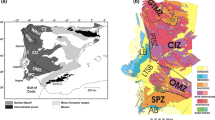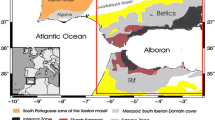Abstract
Receiver functions are widely employed to detect P-to-S converted waves and are especially useful to image seismic discontinuities in the crust. In this study we used the P receiver function technique to investigate the velocity structure of the crust beneath the Northwest Zagros and Central Iran and map out the lateral variation of the Moho boundary within this area. Our dataset includes teleseismic data (M b ≥ 5.5, epicentral distance from 30° to 95°) recorded at 12 three-component short-period stations of Kermanshah, Isfahan and Yazd telemetry seismic networks. Our results obtained from P receiver functions indicate clear Ps conversions at the Moho boundary. The Moho depths were firstly estimated from the delay time of the Moho converted phase relative to the direct P wave beneath each network. Then, we used the P receiver function inversion to find the properties of the Moho discontinuity such as depth and velocity contrast. Our results obtained from PRF are in good agreement with those obtained from the P receiver function modeling. We found an average Moho depth of about 42 km beneath the Northwest Zagros increasing toward the Sanandaj-Sirjan Metamorphic Zone and reaches 51 km, where two crusts (Zagros and Central Iran) are assumed to be superposed. The Moho depth decreases toward the Urmieh-Dokhtar Cenozoic volcanic belt and reaches 43 km beneath this area. We found a relatively flat Moho beneath the Central Iran where, the average crustal thickness is about 42 km. Our P receiver function modeling revealed a shear wave velocity of 3.6 km/s in the crust of Northwest Zagros and Central Iran increasing to 4.5 km/s beneath the Moho boundary. The average shear wave velocity in the crust of UDMA as SSZ is 3.6 km/s, which reaches to 4.0 km/s while in SSZ increases to 4.3 km/s beneath the Moho.
Similar content being viewed by others
References
Afsari N (2008) Crustal structure and azimuthal shear wave velocity anisotropy in Northwest of Zagros (Kermanshah) and Central Iran (Yazd and Isfahan) using teleseismic Ps converted phases. PhD thesis, Science and Research Branch, Islamic Azad University (IAU)
Afsari N, Sodoudi F, Gheitanchi MR, Kaviani A (2010) Moho depth variations and vp/vs ratio in Northwest of Zagros (Kermanshah Region) using teleseismic receiver functions. Geoscience 19(74):45–50
Agard P, Omrani L, Jolivet, Mouthereau F (2005) Convergence history across Zagros (Iran): constrains from collisional and earlier deformation. Int J Earth Sci 94:401–419. doi:10.1007/s00531-005-0481-4
Ammon CJ (1990) On the nonuniqueness of receiver function inversions. J Geophys Res 95:2504–2510
Asudeh I (1982) Seismic structure of Iran from surface and body wave data. Geophys J R Astron Soc 71:715–730
Berberian M (1995) Master blind thrust faults hidden under the Zagros folds: active basement tectonics and surface morphotectonics. Tectonophysics 241:193–224
Berberian M, King GCP (1981) Towards a paleogeography and tectonic evolution of Iran. Can J Earth Sci 18:210–265
Davoudzadeh M, Lammerer B, Weber-Diefenbach K (1997) Paleogeography, stratigraphy, and tectonics of the tertiary of Iran. N Jb Geol Palàont Abh 205:33–67
Dehgani G, Makris J (1984) The gravity field and crustal structure of Iran. N Jb Geol Palaont Abh 168:215–229
Dewey JW, Grantz A (1973) The Ghir earthquake of April 10, 1972 in the Zagros mountains of southern Iran; seismotectonic aspects and some results of a field reconnaissance. Bull Seismol Soc Am 63:2071–2090
Falcon NL (1974) Southern Iran: Zagros mountains. Spec Pub Geol Soc Lond 4:199–211
Giese P, Makris J, Akashe B, Röwer P, Letz H, Mostaanpour M (1984) The crustal structure in Southern Iran derived from seismic explosion data. N Jb Geol Palaeont Abh 168:230–243
Haskell NA (1962) Crustal reflections of plane P and SV waves. J Geophys Res 67:4751–4767
Hatzfeld D, Tatar M, Priestley K, Ghafory-Ashtiany M (2003) Seismological constrains on the crustal structure beneath the Zagros mountain belt (Iran). Geophys J Int 155:403–410
Jackson J, Haines J, Holt W (1995) The accommodation of Arabia-Eurasia plate convergence in Iran. J Geophys Res 100:15205–15219
Kennett BLN, Engdahl ER (1991) Travel times for global earthquake location and phase identification. Geophys J Int 105:429–465
Kind R, Kosarve G, Peterson NV (1995) Receiver function at the stations of the German Regional Seismic Network (GRSN). Geophys J Int 121:191–202
Paul A, Kaviani A, Hatzfeld D, Vegne J, Mokhtari M (2006) Seismological evidence for crustal- scale thrusting in the Zagros mountain belt (Iran). Geophys J Int 166:227–237. doi:10.1111/j.1365-24x.2006.02920.x
Paul A, Hatzfeld D, Kaviani A, Tatar M, Pequegnat C (2010) Seismic imaging of the lithospheric structure of the Zagros mountain belt (Iran). Geol Soc London Special Publications 330:5–18. doi:10.1144/SP330.2
Ramesh DS, Wakatsu HK, Watada S, Yuan X (2005) Receiver function images of the central Chugoku region in the Japanese islands using Hi-net data. Earth Planets Space 57(4):271–280
Ricou LE, Braud J, Brunn J (1977) Le Zagros Mem. h. ser. Soc Geol Fr 8:33–52
Snyder DB, Barazangi M (1986) Deep crustal structure and flexture of the Arabian plate beneath the Zagros collisional mountain belt as inferred from gravity observation. Tectonics 5:361–373
Sodoudi F, Kind R, Priestly W, Hanka W, Wylegalla K, Stavrakakis G, Vafidis A, Harjes HP, Bohnhoff M (2006) Lithospheric structure of the Aegean obtained from P and S receiver functions. J Geophys Res 11:12307–12330
Sodoudi F, Yuan X, Kind R, Heit B, Sadidkhouy A (2009) Evidence for a missing crustal root and a thin lithosphere beneath the Central Alborz by receiver function studies. Geophys J Int 177(2):733–742
Stammler K (1993) Seismichandler-programmable multichannel data handler for interactive and automatic processing of seismological analyses. Comput Geosci 19:135–140
Stöcklin J (1968) Structural history and tectonics of Iran: a review. AAPG Bull 52:1229–1258
Stöcklin J (1974) Possible ancient continental margin in Iran. In: Burke C, Drake C (eds) Geology of continental margins. Springer, New York, pp 873–877
Stoneley R (1981) The geology of the Kuh-e Dalnesh area of Southern Iran, and its bearing on the evolution of Southern Tethys. J Geol Soc Lond 138:509–526
Taghizadeh-Farahmand F, Sodoudi F, Afsari N, Ghassemi MR (2010) Lithospheric structure of NW Iran from P and S receiver functions. J Seismology 14:823–836. doi:10.1007/s10950-010-9199-2
Talebian M, Jackson J (2004) A reappraisal of earthquake focal mechanisms and active shortening in the Zagros mountains of Iran. Geophys J Int 156:506–526
Tchalenko JS, Braud J (1974) Seismicity and structure of the Zagros (Iran): in the Main Recent Fault between 33o and 35o N. Philos Trans R Soc Lond 227:1–25
Vernant P, Niloforoushan F, Hatzfeld D, Abbassi MR, Vigny C, Masson F, Nankali H, Martinod J, Ashtiani A, Bayer R, Tavakoli F, Chery J (2004) Present- day crustal deformation and plate kinematics in the Middle East constrained by GPS measurements in Iran and northern Oman. Geophys J Int 157:381–398
Wessel P, Smith WHF (1998) New, improved version of Generic Mapping Tools Released. EOS Trans Am Geophys Union 79:579
Woelbern I, Rümpker G, Schumann A, Muwanga A (2010) Crustal thinning beneath the Rwenzori region Albertine rift, Uganda, from receiver function analysis. Int J Earth Sci 99:1545–1557. doi:10.1007/s00531-009-0509-2
Zhu L (2000) Crustal structure across the San Andreas Fault, southern California from teleseismic converted waves. Earth Planet Sci Lett 179:183–190
Author information
Authors and Affiliations
Corresponding author
Rights and permissions
About this article
Cite this article
Afsari, N., Sodoudi, F., Taghizadeh Farahmand, F. et al. Crustal structure of Northwest Zagros (Kermanshah) and Central Iran (Yazd and Isfahan) using teleseismic Ps converted phases. J Seismol 15, 341–353 (2011). https://doi.org/10.1007/s10950-011-9227-x
Received:
Accepted:
Published:
Issue Date:
DOI: https://doi.org/10.1007/s10950-011-9227-x




